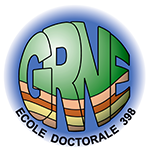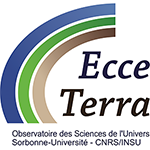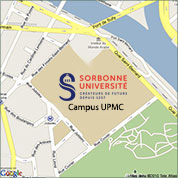Séminaire ISTeP - Jonas Ruh
(ISTeP)
Numerical modelling of mechanics along subduction zones: from accretionary wedge dynamics to deep crustal slicing
(i) Thin-skinned fold-and-thrust belts related to convergence tectonics develop by scraping off a rock sequence along a weaker basal décollement often formed by water-saturated shale layers or low-viscosity salt horizons. A two-dimensional finite element model with a viscoelastoplastic rheology is used to investigate the structural evolution of fold-and-thrust belts overlying different types of décollements. In addition, the influence of multiple weak layers in the stratigraphic column is studied. Model shale décollements are frictional, with lower friction angles as the cover sequence. Model salt layers behave linear viscous, due to a lower viscosity as the cover sequence. Single viscous décollement simulations have been compared to an analytical solution concerning faulting versus folding.
(ii) Slivers of high-pressure low-temperature metamorphic oceanic crust are observed in many mountain belts. These blueschist and eclogites were detached from the descending plated during subduction. Large-scale thermo-mechanical numerical models based on finite difference, marker-in-cell technique, are applied to investigate mechanical processes that lead to the detachment of oceanic slivers and their exhumation independent of continental collision. In particular, the influence of serpentinized upper slab mantle on shallow and deep crustal slicing is tested. Results show that continuous serpentinization of oceanic mantle leads to complete accretion of oceanic crust at accretionary wedge levels. Discontinuous serpentinization of the slab mantle in form of unconnected patches can lead to shallow slicing of the oceanic crust below the accretionary wedge and deep slicing at mantle depth depending on patch length, slab angle, convergence velocity and continental geothermal gradient. P-T paths obtained in this study are compared to natural examples of shallow slicing of the Crescent Terrane below Vancouver Island and deeply sliced crust of the Lago Superiore and Saas-Zermatt units in the Western Alps.
29/05/2015 à 12h30, Salle Fourcade (Tour 55/56, 4ème étage)
Egalement dans la rubrique
- Séminaire ISTeP - Chrystèle Sanloup
- Séminaire ISTeP - Marco Scambelluri
- Séminaire ISTeP - Déborah Chavrit
- Séminaire ISTeP - Evgueni Burov
- Séminaire ISTeP - Anne Le Friant
- Séminaire ISTeP - Pierre Valla
- Séminaire ISTeP - Ramadan Ghalayini
- Séminaire ISTeP - Matthias Delescluse
- Séminaire ISTeP - Séverine Moune
- Séminaire ISTeP - Lucie Tajcmanova
- Séminaire ISTeP - Gabriel Coelho
- Séminaire ISTeP - Laurie Bougeois
- Séminaire ISTeP - Jacques Touret
- Séminaire ISTeP - Sanae El Janyani
- Séminaire ISTeP - Arthur Paté
- Séminaire ISTeP - Nicolas Beaudoin
- Séminaire ISTeP - Kosuke Ueda
- Séminaire ISTeP - Ali Hannouche
- Séminaire ISTeP - Benjamin Cochain
- Séminaire ISTeP - Behzad Nasri
- Séminaire ISTeP - Daniel Pastor Galan
- Séminaire ISTeP - Sara Lafuerza Colas
- Séminaire ISTeP - Jean-Pierre Suc
- Séminaire ISTeP - Pierpaolo Zuddas
- Séminaire ISTeP - Agnès Elmaleh
- Séminaire ISTeP - John Wakabayashi
- Séminaire ISTeP - Timm John
Chiffres clés (Mars 2025)
L'ISTeP comprend 131 membres dont :
Permanents (66)
- Professeurs : 17 (+2 PAST)
- Maîtres de conférence : 26
- Directeurs de recherche CNRS : 1
- Chargés de recherche CNRS : 1
- ITA : 19
Personnels non permanents (65)
- Collaborateurs bénévoles / émérites : 17
- Chaire de professeur junior : 1
- Enseignants-chercheurs contractuel : 2
- 1 MCF accueil en délégation
- ATER et Post-Docs : 9
- Doctorants : 32
- ITA-BIATSS : 3





